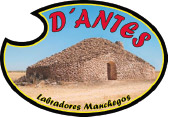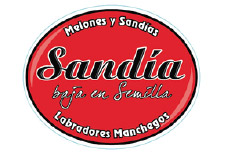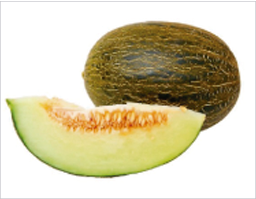
MELONS & WATERMELONS
"Piel de Sapo" Melon
Our “Piel de Sapo” melon is a genuine product, natural and durable. The sweetness is over 11º Brix and a great texture.
It contains a high quantity of water (90-95%) and a quantity of sugar (6%) which is lower than that of other fruits. Moreover, the quantity of fat is pretty low which place melon as one of the lowest calories content fruit.
It provides high quantity of vitamins and minerals. Specifically, 100 grams of melon without rind, provides half daily dose of vitamin C recommended and along with orange is one of the fruits with more folic acid.
It's important to mention the high content of Provitamin A (mainly beta-carotene). Beta-carotene also become vitamin A in our body and has an important role to prevent against diseases such as cancer, cardiovascular disease and cataracts, due to its antioxidant capacity and the control of the immune response.
Regarding minerals, highlight its richness in potassium, but also contains high quantity of phosphorus and magnesium.
The high quantity of water in this fruit stimulates the kidneys to work more efficiently, helping the elimination of waste substances and toxins, improving renal function. It is also indicated in cases of dehydration or loss of minerals (diarrhea, heavy sweating and febrile seizures).
Melon (Cucumis melo L.)
Fruit from the plant of the same name, herbaceous plant with a trailing stem that belongs to the Cucurbitaceae family. Its shape is normally round or oval with smooth or netted skin. The flesh may be white, yellow, orange or greenish.
It is native from western Asia and Africa (the origin is uncertain). Its name comes from the Greek word 'melon' which means 'big apple'.
"Piel de Sapo" melon is ellipsoidal or ovoid.
The rind may be smooth or slightly roughened with an average thickness of 0.6 to 0.8 cm. Dominates the green skin with dark spots, evenly distributed, which become yellow when mature. However, the "bed" or contact area with the ground which does not receive sunlight, it is always yellowish due to lack of chlorophyll formation.
The pulp is white or creamy colour. The placental area is orange; it has been located in the centre of the fruit where the seeds are.
| Composition | Amount per 100 grams of edible portion | Recommended intake |
|---|---|---|
Water (g) |
92.4 |
- |
Energy (kcal) |
25 |
3000 - 2300 |
Proteins (g) |
0.6 |
54 - 41 |
Carbohydrates (g) |
6 |
450 - 350 (a) |
Lipids (g) |
Traces |
90 - 80 (a) |
Fiber |
|
|
Total fiber (g) |
0.73 |
> 30 (a) |
Soluble (g) |
0.19 |
12 (a) |
Insoluble (g) |
0.54 |
18 (a) |
Vitamins |
|
|
Vitamin A (Eq. Retinol) (µg) |
784 |
1000 - 800 |
Total Carotenoids (µg) |
4700 |
- |
Alpha-carotene (µg) |
30 |
- |
Beta-carotene (µg) |
4700 |
- |
Cryptoxanthin (µg) |
29 |
- |
Vitamin E (mg) |
0.1 |
10 - 8 |
Vitamin B1 (mg) |
0.04 |
1.2 - 1.1 |
Vitamin B2 (mg) |
0.02 |
1.3 - 1.2 |
Niacin (mg) |
0.5 |
16 - 15 |
Vitamin B6 (mg) |
0.07 |
1.5 - 1.3 |
Folate (µg) |
30 |
400 |
Vitamin C (mg) |
25 |
60 |
Minerals |
|
|
Calcium (mg) |
14 |
1000 - 1200 |
Iron (mg) |
0.4 |
10 - 15 |
Phosphorus (mg) |
24 |
700 |
Magnesium (mg) |
17 |
400 - 350 |
Zinc (mg) |
0.1 |
15 - 12 |
Selenium (µg) |
0.5 |
70 - 55 |
Sodium (mg) |
14 |
- |
Potassium (mg) |
320 |
- |
Carotenoids without vitamin A activity |
|
|
Lutein (µg) |
2 |
- |
Zeaxanthin(µg) |
traces |
- |
Lycopene (µg) |
0 |
- |
Recommended intake: Recommendations of energy and nutrients for men and women 20 to 39 years.
(a) Approximate quantities for men and women considering nutritional goals.



Watermelon
Watermelon, Black Watermelon 'Pome' and Black Watermelon 'seedless'. Highlighting the last one for its great taste, rich color and durability..
It is the fruit that more water contains (95%), so it provides very little energy (18 kcal per 100 grams), and generally low in nutrients, although it contains high amounts of different vitamins and minerals.
Highlighting in its composition is the content of carotenoids (lutein and lycopene). Lycopene is found in a large amount, this being one of the main food sources of dietary phytochemicals.
Statistics have linked the consumption of lycopene with a reduced risk of cardiovascular disease because it lowers blood cholesterol levels and the protection against some cancers such as cervical, prostate, lung, breast and digestive tract (colon, rectum, esophagus, stomach, pharynx ...).
Furthermore, the high water content stimulates the kidneys to work more efficiently, facilitating the removal of waste products and toxins, which improve kidney function.
Watermelon (Citrullus lanatus)
Fruit from the plant of the same name, herbaceous plant with a trailing stem that belongs to the Cucurbitaceae family.
Watermelon is an ancient fruit whose origin is in tropical Africa. Its cultivation dates back to 3500 years ago, located in the Nile valley, as shown by the hieroglyphics and sculptures found in ancient Egypt.As we don't have quotes about watermelon in classical antiquity, it is thought that its introduction in the Greco-Roman world was quite late. Arabs were great consumers of this fruit that provided them detoxifying properties. Europeans brought watermelon to America, where its cultivation spread throughout the country..
It is one of the largest fruits as it can reach up to 20 kilograms and increase his diameter up to 30 inches. However, the new market requirements and European tastes make that the watermelons grown for export to have a weight between 3-8 kg, tending to reduce it down to pieces of 2 kg or less..
It shows a hard and smooth rind, between 2-4 centimeters thick. The skin and pulp watermelon colours characterize it in a special way because of the different beautiful contrasts. In its mature stage, the colour varies between green and yellow, with the possibility of getting a green colouring with specks of yellowish, greenish or light-green. It can also stand out for their red colour, although depending on the varieties also pink and orange tones.
The seeds are scattered inside the pulp and are black-brown in colour, very hard seeds. However other type of watermelons is called "seedless", which contain seeds very soft and in whitish and yellowish colours.
The watermelon taste is a combination between refreshing and sweet, making it a very attractive fruit facing the hot summer.
| Composition | Amount per 100 grams of edible portion | Recommended intake |
|---|---|---|
Water (g) |
94.6 |
- |
Energy (kcal) |
18 |
3000 - 2300 |
Proteins (g) |
0.4 |
54 - 41 |
Carbohydrates (g) |
4.5 |
450 - 350 (a) |
Lipids (g) |
Tr |
90 - 80 (a) |
Fiber |
|
|
Total Fiber (g) |
0.22 |
> 30 (a) |
Soluble (g) |
0.20 |
12 (a) |
Insoluble (g) |
0.02 |
18 (a) |
Vitamins |
|
|
Vitamin A (Eq. Retinol) (µg) |
87 |
1000 - 800 |
Total Carotenoids (µg) |
795 |
- |
Beta-carotene (µg) |
245 |
- |
Cryptoxanthin (µg) |
490 |
- |
Vitamin E (mg) |
0.1 |
10 - 8 |
Vitamin B1 (mg) |
0.02 |
1.2 - 1.1 |
Vitamin B2 (mg) |
0.02 |
1.3 - 1.2 |
>Niacin (mg) |
0.3 |
16 - 15 |
Vitamin B6 (mg) |
0.07 |
1.5 - 1.3 |
Folate (µg) |
3 |
400 |
Vitamin C (mg) |
5 |
60 |
Minerals |
|
|
Calcium (mg) |
7 |
1000 - 1200 |
Iron (mg) |
0.3 |
10 - 15 |
Phosphorus (mg) |
9.2 |
700 |
Magnesium (mg) |
11 |
400 - 350 |
Zinc (mg) |
0.1 |
15 - 12 |
Selenium (µg) |
0.4 |
70 - 55 |
Sodium (mg) |
4 |
- |
Potassium (mg) |
120 |
- |
Carotenoids without vitamin A activity |
|
|
Lutein (µg) |
40 |
- |
Lycopene (µg) |
2454 |
- |
Recommended intake: Recommendations of energy and nutrients for men and women 20 to 39 years.
(a) Approximate quantities for men and women considering nutritional goals.







